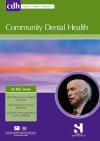Community Dental Health

- Cover Date:
- March 2016
- Print ISSN:
- 0265 539X
- Vol:
- 33
- Issue:
- 1
Dental service provision by oral health therapists, dental hygienists and dental therapists in Australia: implications for workforce modelling
Dental service provision by oral health therapists, dental hygienists and dental therapists in Australia: implications for workforce modelling
Objective: Dental service provision rates are necessary for workforce planning. This study estimates patient and service rates for oral health therapists (OHTs), dental hygienists (DHs) and dental therapists (DTs). To identify important variables for workforce modelling, variations in rates by practice characteristics were assessed. Design: A cross-sectional self-complete mailed questionnaire collected demographic and employment characteristics, and clinical activity on a self-selected typical day of practice. Setting: Private and public dental practices in
Australia.
Key words: dental services, dental service provision rates, dental hygienists, dental therapists, oral health therapists, practice activity, workforce planning, Australia
doi:10.1922/CDH_3848Teusner08
- Article Price
- £15.00
- Institution Article Price
- £
- Page Start
- 15
- Page End
- 22
- Authors
- D.N. Teusner, N. Amarasena, J. Satur, S. Chrisopoulos, D.S. Brennan
Articles from this issue
- Title
- Pg. Start
- Pg. End
- Dental service provision by oral health therapists, dental hygienists and dental therapists in Australia: implications for workforce modelling
- 15
- 22
- A randomized controlled trial of cluster audit and feedback on the quality of dental sealant for rural schoolchildren
- 27
- 32
- Identification of barriers and beliefs influencing engagement by adult and teen Mexican-Americans in oral health behaviors
- 44
- 47
- Are oral health-related self-efficacy, knowledge and fatalism indicators for non-toothbrush ownership in a homeless population?
- 48
- 53
- Sense of coherence modifies the association between untreated dental caries and dental pain in low-social status women
- 54
- 59
